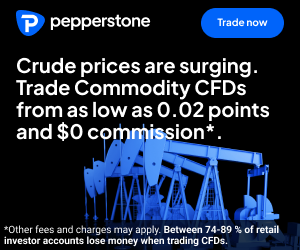CAMBRIAN POINTS AND THEIR USE IN FOREX STRATEGIES
Cambrian points are reference levels used in certain technical frameworks to map out potential turning points in currency markets. Though less well-known than traditional tools like moving averages or Fibonacci retracements, Cambrian points aim to highlight areas where price action may shift direction. For traders, understanding how these levels are defined, identified, and applied in practice can add another layer of insight to strategy and risk management.

Cambrian Points Defined
In technical analysis, traders have long relied on reference points to frame decisions: support and resistance levels, pivot points, Fibonacci retracements, and moving averages. Cambrian points fall into this broad category of reference levels, but with their own logic and structure. They are designed to highlight potential zones of price reaction, where currencies might reverse direction, consolidate, or accelerate. While they are not as widely recognised as classical charting tools, they represent a growing area of interest among systematic traders and strategists looking for alternative frameworks.
Origins of the Concept
The term “Cambrian” is borrowed from the Cambrian explosion in natural history—a period marked by rapid diversification of life forms. In trading, the idea suggests points of branching: levels at which price action can diverge into multiple paths. Some analysts frame Cambrian points as pre-determined thresholds where probabilities shift, much like pivot points, though the underlying methodology can differ depending on the system used.
Unlike Fibonacci retracements, which are grounded in a mathematical sequence, or moving averages, which are statistical summaries of past prices, Cambrian points are often derived from a blend of historical volatility, price extremes, and fractal geometry. This means there is no single universal formula. Instead, different trading groups and proprietary desks adapt the idea to fit their models, making it something of a niche but flexible approach.
How Cambrian Points Differ from Other Tools
Traditional technical tools often focus on either trend confirmation or mean reversion. Cambrian points attempt to straddle both. By marking out levels that might act as branching zones, they acknowledge that markets are not deterministic but probabilistic. A Cambrian point does not guarantee a reversal or a breakout—it highlights where either outcome is statistically more likely. In this way, Cambrian points embody the trader’s challenge: preparing for multiple scenarios while managing risk exposure.
This probabilistic framing is appealing in Forex, where liquidity is deep, information is widely distributed, and sudden shifts are common. Unlike equities, where earnings or corporate news can provide anchors, currencies often move on diffuse macroeconomic themes, sentiment shifts, or even technical flows. Cambrian points give traders a map of potential inflection areas, even when fundamentals are ambiguous.
The Anatomy of a Cambrian Point
Although methodologies vary, Cambrian points typically share three features:
- Historical Reference: Many frameworks use past highs, lows, or volatility bands as anchors. Cambrian points may sit just beyond obvious support or resistance to capture “stop zones” where liquidity pools.
- Fractal Scaling: Some models calculate Cambrian points on multiple timeframes, creating a nested structure. A Cambrian point on a daily chart may coincide with several points on shorter charts, strengthening its significance.
- Probabilistic Boundaries: Rather than marking precise levels, Cambrian points are often treated as zones. This reflects the reality that markets rarely pivot on a single pip but within a range of contested prices.
Applications in Forex Context
Forex markets are particularly suited to the application of Cambrian points because of their round-the-clock trading and tendency to oscillate around macro themes. Traders who plot Cambrian points can use them as filters for noise, focusing attention on where volatility and liquidity are most likely to collide. For example, EUR/USD may drift quietly through the European session but approach a Cambrian point derived from historical volatility. As New York opens, order flow intensifies, and the pair either rejects or surges through that level. The Cambrian point thus acts as a signal that a significant move is imminent.
Strengths and Weaknesses
Like any technical tool, Cambrian points have strengths and weaknesses. Their strength lies in their adaptability and probabilistic nature, which fits the uncertainty of markets. They can also be layered across timeframes to identify confluences, adding depth to analysis. However, their weaknesses are equally clear: they lack standardisation, can be prone to subjective interpretation, and are not widely recognised, which reduces their self-fulfilling power compared to mainstream tools like Fibonacci levels.
For this reason, Cambrian points are often best used in conjunction with other indicators. A trader may combine them with momentum oscillators, moving averages, or macroeconomic calendars to validate whether a Cambrian point is likely to hold or break. They should not be used in isolation but as part of a toolkit.
Why Traders Pay Attention
The attraction of Cambrian points lies partly in their novelty. Markets are crowded with participants using the same tools and watching the same levels. When too many eyes focus on a Fibonacci retracement or a round number, moves can become crowded and prone to false breaks. Cambrian points offer an alternative framework, potentially highlighting areas less obvious to the broader market. This “off-the-beaten-path” quality is valuable to traders seeking an edge.
Moreover, for systematic or algorithmic traders, Cambrian points provide a way to encode probabilistic branching into their models. By backtesting how often certain levels produce reversals or continuations, they can refine execution strategies that take advantage of these inflection zones. Even if the broader market is not watching Cambrian points explicitly, their statistical validity can still make them useful.
The Future of Cambrian Points
As trading evolves, especially with the rise of machine learning and alternative data, concepts like Cambrian points may gain broader traction. Their focus on probabilistic outcomes rather than deterministic predictions aligns with how advanced algorithms increasingly model markets. For discretionary traders, the challenge will be to integrate these points without overcomplicating strategies. For institutions, the opportunity lies in standardising methodologies and testing their robustness across market regimes.
In sum, Cambrian points represent both an innovation and a reminder. They innovate by offering a fresh framework for mapping potential outcomes. They remind us that markets are not linear machines but branching systems, where each level carries the possibility of multiple paths. For Forex traders, defining and understanding Cambrian points can therefore add a valuable dimension to strategy, risk management, and perspective.
Identifying Levels
Defining what Cambrian points are is only half the task. The real challenge for traders lies in learning how to identify them with precision and consistency. Unlike simple horizontal support or resistance, Cambrian points are probabilistic zones that require careful analysis, blending historical data, volatility patterns, and structural features of the market. In this section, we explore the main methods used to identify Cambrian points in practice, and how traders adapt them across different timeframes.
Historical Highs and Lows
The most straightforward approach to spotting Cambrian points is to begin with historical highs and lows. Markets have memory, and prices often react when revisiting past extremes. Cambrian points may be set slightly beyond these levels, accounting for the tendency of price to overshoot before reversing. This technique recognises that stop orders and option barriers often cluster around these levels, creating liquidity pockets where sharp moves can occur.
For example, in EUR/USD, a prior multi-year high might act as a Cambrian point zone. If the pair approaches that level with building momentum, traders anticipate either a strong rejection or a breakout. By plotting this level and treating it as a probabilistic branch, traders prepare for both outcomes—positioning for continuation if volume confirms a breakout, or fading the move if momentum stalls.
Volatility-Based Approaches
Another method is to anchor Cambrian points to volatility bands. Here, the idea is to calculate average price ranges—daily, weekly, or monthly—and project zones where extreme moves are statistically likely. This is similar in spirit to Bollinger Bands but with a broader focus on probabilistic branching rather than mean reversion alone. For instance, if GBP/USD typically moves 100 pips in a day, then a 150-pip swing may define a Cambrian point, as the odds of further extension diminish or increase depending on sentiment.
This approach is particularly popular with quantitative desks. By modelling volatility distributions, they can generate dynamic Cambrian points that shift as conditions change. During calm markets, Cambrian points are tighter, while in high-volatility regimes, they expand. This adaptability makes them especially useful in FX, where volatility can shift dramatically after central bank announcements or geopolitical shocks.
Fractal and Multi-Timeframe Analysis
Cambrian points are most powerful when they align across multiple timeframes. A level identified on a daily chart carries more weight if it coincides with a Cambrian point on a four-hour or hourly chart. This fractal approach mirrors the idea that markets move in nested structures, with patterns repeating across scales. Traders who look for these alignments can identify high-probability zones where liquidity is concentrated across both short- and long-term participants.
Fractal analysis also helps distinguish between noise and significance. A Cambrian point that exists only on a five-minute chart may be less reliable than one confirmed on the daily timeframe. However, in scalping strategies, even the smaller points can provide tactical entry or exit cues. The art lies in matching timeframe to trading horizon and risk appetite.
Market Microstructure Insights
Beyond charts and statistics, Cambrian points can be derived from market microstructure—the mechanics of order flow and liquidity. Large institutional players, such as hedge funds and banks, often place significant orders at predictable thresholds. These orders create supply or demand imbalances that can serve as Cambrian points. Traders who track order book data, option expiries, or reported flows can anticipate where these inflection points may arise.
For example, if a cluster of EUR/USD options expire at 1.1000 with heavy notional value, traders may treat that strike as a Cambrian point. Price action around expiry often sharpens volatility, producing either rejection or acceleration. These levels, while not fixed forever, function as temporary Cambrian points where market behaviour can branch in multiple directions.
Combining Technical and Fundamental Inputs
Cambrian points do not need to be purely technical. In practice, many traders overlay them with fundamental catalysts such as central bank announcements, payroll data, or inflation prints. For instance, if USD/JPY approaches a Cambrian point level on the same day the Bank of Japan is expected to release new policy guidance, the likelihood of a strong reaction multiplies. These hybrid approaches acknowledge that market turning points are shaped not only by past price data but also by new information shocks.
This integration is particularly relevant in Forex, where news flow is constant and global. A Cambrian point that aligns with a major economic release can act as a pressure valve, releasing pent-up volatility. Traders who anticipate this convergence can design strategies that capture the resulting moves with defined risk.
Tools and Technology
Identifying Cambrian points manually is possible but labour-intensive. Increasingly, traders rely on software and algorithms to calculate and update levels in real time. Platforms can scan historical ranges, volatility clusters, and fractal overlaps to generate a live map of Cambrian zones. These tools allow traders to focus less on computation and more on interpretation and execution.
Retail traders are not excluded. Many charting platforms now offer custom indicators where Cambrian-style logic can be coded. Even without institutional-grade data, individuals can replicate the principles using volatility bands, pivot overlays, and multi-timeframe support/resistance zones. While not identical, these proxies provide a starting point for integrating Cambrian concepts into daily practice.
Challenges in Identifying Cambrian Points
The flexibility of Cambrian points is both a strength and a weakness. Without a single accepted formula, traders risk inconsistency. Two analysts may plot different Cambrian zones on the same chart, leading to conflicting interpretations. Moreover, the probabilistic nature of Cambrian points means they will not always “work”—price may slice through a level without hesitation. The key is to treat them as guides, not guarantees, and to pair them with disciplined risk management.
This uncertainty can frustrate traders accustomed to more rigid frameworks. However, it also reflects market reality: no level, no matter how carefully calculated, is absolute. Cambrian points offer a structured way to embrace that uncertainty, mapping potential branches rather than promising certainty.
Putting It All Together
The process of identifying Cambrian points is ultimately about pattern recognition and probability. Traders must gather historical context, assess volatility, check for fractal confluence, and consider order flow dynamics. Each piece adds to the map, refining zones where outcomes are most likely to diverge. The more signals align, the stronger the Cambrian point becomes as a reference.
When applied consistently, this method allows traders to transform raw price data into actionable levels. By viewing these points as probabilistic branches, traders prepare not only for one outcome but for multiple scenarios. This flexibility is invaluable in Forex, where uncertainty is the rule rather than the exception.
Trading Applications
Identifying Cambrian points is valuable, but their true power emerges when traders integrate them into actionable strategies. These points are not merely academic curiosities; they are practical tools for structuring trades, managing risk, and understanding market behaviour. In this section, we examine the different ways Cambrian points can be applied, from building entry and exit rules to shaping broader portfolio strategies in Forex.
Using Cambrian Points as Entry Triggers
One of the most direct applications is to use Cambrian points as entry levels. Traders often wait for price to approach a Cambrian zone before committing capital, as these levels represent high-probability areas for market turns or accelerations. The logic is straightforward: when price reaches a zone of structural importance, outcomes multiply. By preparing in advance, traders can capture favourable risk-to-reward opportunities.
There are two common approaches here. First, traders can fade Cambrian points, betting that price will reverse at the level. For example, if EUR/USD approaches a Cambrian resistance zone and momentum stalls, a trader might short the pair, anticipating a retracement. Second, they can trade breakouts, entering in the direction of the move once the level is breached with conviction. In both cases, the Cambrian point acts as the reference for decision-making, with clear invalidation if price fails to respect the level.
Defining Exit Strategies
Cambrian points are equally useful for setting exit rules. Traders can place take-profit targets near Cambrian levels, anticipating that price may stall or reverse there. This is particularly effective when combined with trailing stops, allowing traders to lock in gains while still participating if price pushes through the zone. In practice, many traders build “laddered” exits around Cambrian points, scaling out of positions as the market approaches successive zones.
This method also helps avoid the psychological trap of greed. By planning exits around pre-identified Cambrian points, traders can reduce the temptation to hold for unrealistic gains. The discipline of using structured levels fosters consistency over time, which is often more valuable than any single trade outcome.
Risk Management and Stop Placement
Risk management is where Cambrian points shine. Because these levels represent areas where market behaviour could shift sharply, they provide logical zones for stop-loss placement. A stop set just beyond a Cambrian point ensures that if the market invalidates the level, the trader exits before losses mount. This creates a natural symmetry: trades are opened near Cambrian zones for their potential turning power, and closed if price proves that the level no longer holds.
Institutional desks frequently rely on this principle. By mapping Cambrian points across major pairs, they can size positions with precision, knowing that the distance to invalidation is defined. This allows for more efficient use of leverage, as the downside risk is anchored to an observable level rather than guesswork.
Scenario Planning and Probabilistic Thinking
A defining feature of Cambrian points is their ability to support probabilistic thinking. Instead of assuming a single outcome, traders can build scenarios: “If the price rejects this Cambrian point, I will fade the move; if it breaks, I will join the trend.” This mindset mirrors the branching idea behind the concept itself, preparing traders to adapt rather than react emotionally.
This adaptability is particularly valuable during volatile events such as central bank decisions. A Cambrian point near a policy-sensitive level provides a roadmap for both potential outcomes. Regardless of whether the dollar strengthens or weakens, the trader is prepared with defined strategies tied to the same structural point.
Multi-Asset and Cross-Pair Applications
Although Cambrian points are most often discussed in the context of individual currency pairs, their influence can extend across assets. For example, a Cambrian point in gold may align with turning points in commodity-linked currencies such as AUD/USD. Similarly, a Cambrian point in the Dollar Index (DXY) can provide signals that resonate across multiple dollar pairs at once.
This cross-asset perspective allows traders to diversify strategies while still using a consistent framework. If several assets converge around Cambrian points simultaneously, the probability of meaningful moves increases. Traders can allocate capital across correlated instruments, balancing risk while leveraging shared signals.
Short-Term vs Long-Term Strategies
Cambrian points are flexible across timeframes. Scalpers may focus on intraday Cambrian zones that capture sharp reversals within minutes. Swing traders, meanwhile, rely on daily or weekly Cambrian points to frame multi-day positions. Long-term investors may even map monthly Cambrian zones to assess structural turning points in macro cycles.
Each horizon requires adjustment in execution. A scalper might wait for a candlestick rejection at a Cambrian level before entering, while a swing trader may demand confirmation from multiple indicators. Despite these differences, the unifying principle is that Cambrian points act as decision hubs across every timeframe, tailoring their utility to the trader’s style.
Algorithmic and Systematic Integration
With the rise of algorithmic trading, Cambrian points are increasingly integrated into systematic strategies. Algorithms can be programmed to monitor price interaction with Cambrian zones, triggering entries, exits, or alerts automatically. This removes the human bias of hesitation and ensures that strategies are executed consistently.
Some funds use Cambrian points as part of ensemble models, combining them with momentum indicators or machine-learning outputs. By treating Cambrian points as one factor among many, they enhance robustness while retaining the structural insights these levels provide. For retail traders, simpler versions can be coded into expert advisors or scripts on platforms such as MetaTrader.
Psychological Benefits for Traders
Beyond numbers, Cambrian points provide psychological clarity. Trading is as much about discipline as analysis, and having predefined levels reduces emotional decision-making. Traders who know where they plan to enter, exit, and cut losses are less likely to succumb to fear or greed. Cambrian points serve as anchors of discipline, ensuring that every trade is backed by a structured rationale.
This structure is especially helpful for newer traders. Without clear frameworks, they may overtrade or chase moves impulsively. By using Cambrian points as signposts, they gain confidence in executing strategies with consistency, even if not every trade is successful.
Limitations and Risks
No trading tool is infallible, and Cambrian points are no exception. Their subjective nature means they can differ across analysts, and false signals are inevitable. Traders must avoid over-reliance, remembering that Cambrian points are probabilistic, not predictive. Overconfidence can lead to oversized positions and unnecessary losses if the market fails to respect the level.
Furthermore, Cambrian points work best in trending or volatile conditions. In low-volatility markets, price may drift through zones with little reaction, frustrating traders who expect sharp reversals. Recognising these contextual limits is essential to applying Cambrian points effectively.
From Concept to Practice
Ultimately, the strength of Cambrian points lies in their ability to bridge theory and practice. They are not fixed formulas but adaptable tools that traders can integrate into their unique approaches. Whether used to trigger entries, define exits, or manage risk, Cambrian points provide a flexible framework rooted in market structure. By viewing them as hubs of probability, traders can anticipate turning points while preparing for multiple outcomes.
The application of Cambrian points is less about prediction and more about preparation. Traders who master this mindset equip themselves to navigate Forex markets with a blend of structure and adaptability—a balance that lies at the heart of successful trading.








